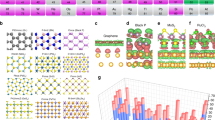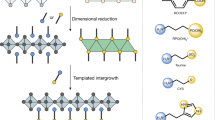Abstract
Two-dimensional materials with monolayer thickness and extreme aspect ratios are sought for their high surface areas and unusual physicochemical properties1. Liquid exfoliation is a straightforward and scalable means of accessing such materials2, but has been restricted to sheets maintained by strong covalent, coordination or ionic interactions3,4,5,6,7,8,9,10. The exfoliation of molecular crystals, in which repeat units are held together by weak non-covalent bonding, could generate a greatly expanded range of two-dimensional crystalline materials with diverse surfaces and structural features. However, at first sight, these weak forces would seem incapable of supporting such intrinsically fragile morphologies. Against this expectation, we show here that crystals composed of discrete supramolecular coordination complexes can be exfoliated by sonication to give free-standing monolayers approximately 2.3 nanometres thick with aspect ratios up to approximately 2,500:1, sustained purely by apolar intermolecular interactions. These nanosheets are characterized by atomic force microscopy and high-resolution transmission electron microscopy, confirming their crystallinity. The monolayers possess complex chiral surfaces derived partly from individual supramolecular coordination complex components but also from interactions with neighbours. In this respect, they represent a distinct type of material in which molecular components are all equally exposed to their environment, as if in solution, yet with properties arising from cooperation between molecules, because of crystallinity. This unusual nature is reflected in the molecular recognition properties of the materials, which bind carbohydrates with strongly enhanced enantiodiscrimination relative to individual molecules or bulk three-dimensional crystals.
This is a preview of subscription content, access via your institution
Access options
Access Nature and 54 other Nature Portfolio journals
Get Nature+, our best-value online-access subscription
$29.99 / 30 days
cancel any time
Subscribe to this journal
Receive 51 print issues and online access
$199.00 per year
only $3.90 per issue
Buy this article
- Purchase on Springer Link
- Instant access to full article PDF
Prices may be subject to local taxes which are calculated during checkout




Similar content being viewed by others
Data availability
The data that support the findings of this study are available from the corresponding authors.
References
Tan, C. et al. Recent advances in ultrathin two-dimensional nanomaterials. Chem. Rev. 117, 6225–6331 (2017).
Nicolosi, V., Chhowalla, M., Kanatzidis, M. G., Strano, M. S. & Coleman, J. N. Liquid exfoliation of layered materials. Science 340, 1226419 (2013).
Hernandez, Y. et al. High-yield production of graphene by liquid-phase exfoliation of graphite. Nat. Nanotechnol. 3, 563–568 (2008).
Kory, M. J. et al. Gram-scale synthesis of two-dimensional polymer crystals and their structure analysis by X-ray diffraction. Nat. Chem. 6, 779–784 (2014).
Coleman, J. N. et al. Two-dimensional nanosheets produced by liquid exfoliation of layered materials. Science 331, 568–571 (2011).
Li, J. et al. Printable two-dimensional superconducting monolayers. Nat. Mater. 20, 181–187 (2021).
Puthirath Balan, A. et al. Exfoliation of a non-van der Waals material from iron ore hematite. Nat. Nanotechnol. 13, 602–609 (2018).
Varoon, K. et al. Dispersible exfoliated zeolite nanosheets and their application as a selective membrane. Science 334, 72–75 (2011).
Peng, Y. et al. Metal-organic framework nanosheets as building blocks for molecular sieving membranes. Science 346, 1356–1359 (2014).
Nicks, J., Boer, S. A., White, N. G. & Foster, J. A. Monolayer nanosheets formed by liquid exfoliation of charge-assisted hydrogen-bonded frameworks. Chem. Sci. 12, 3322–3327 (2021).
Novoselov, K. S. et al. Electric field effect in atomically thin carbon films. Science 306, 666–669 (2004).
Huang, P. Y. et al. Imaging atomic rearrangements in two-dimensional silica glass: watching silica’s dance. Science 342, 224–227 (2013).
Wasio, N. A. et al. Self-assembly of hydrogen-bonded two-dimensional quasicrystals. Nature 507, 86–89 (2014).
Suzuki, Y. et al. Self-assembly of coherently dynamic, auxetic, two-dimensional protein crystals. Nature 533, 369–373 (2016).
Xing, L. B., Peng, Z. T., Li, W. T. & Wu, K. On controllability and applicability of surface molecular self-assemblies. Acc. Chem. Res. 52, 1048–1058 (2019).
Cook, T. R., Zheng, Y.-R. & Stang, P. J. Metal–organic frameworks and self-assembled supramolecular coordination complexes: comparing and contrasting the design, synthesis, and functionality of metal–organic materials. Chem. Rev. 113, 734–777 (2013).
Olenyuk, B., Whiteford, J. A., Fechtenkötter, A. & Stang, P. J. Self-assembly of nanoscale cuboctahedra by coordination chemistry. Nature 398, 796–799 (1999).
Fujita, M., Yazaki, J. & Ogura, K. Preparation of a macrocyclic polynuclear complex, [(en)Pd(4,4'-bpy)]4(NO3)8 (en = ethylenediamine, bpy = bipyridine), which recognizes an organic molecule in aqueous media. J. Am. Chem. Soc. 112, 5645–5647 (1990).
Fujita, M. et al. Self-assembly of ten molecules into nanometre-sized organic host frameworks. Nature 378, 469–471 (1995).
Mal, P., Breiner, B., Rissanen, K. & Nitschke, J. R. White phosphorus is air-stable within a self-assembled tetrahedral capsule. Science 324, 1697–1699 (2009).
Rizzuto, F. J. & Nitschke, J. R. Stereochemical plasticity modulates cooperative binding in a CoII12L6 cuboctahedron. Nat. Chem. 9, 903–908 (2017).
Yamashina, M. et al. An antiaromatic-walled nanospace. Nature 574, 511–515 (2019).
Chen, B., Holstein, J. J., Horiuchi, S., Hiller, W. G. & Clever, G. H. Pd(II) coordination sphere engineering: pyridine cages, quinoline bowls, and heteroleptic pills binding one or two fullerenes. J. Am. Chem. Soc. 141, 8907–8913 (2019).
Yoshizawa, M., Tamura, M. & Fujita, M. Diels-Alder in aqueous molecular hosts: unusual regioselectivity and efficient catalysis. Science 312, 251–254 (2006).
Kaphan, D. M., Levin, M. D., Bergman, R. G., Raymond, K. N. & Toste, F. D. A supramolecular microenvironment strategy for transition metal catalysis. Science 350, 1235–1238 (2015).
Cullen, W., Misuraca, M. C., Hunter, C. A., Williams, N. H. & Ward, M. D. Highly efficient catalysis of the Kemp elimination in the cavity of a cubic coordination cage. Nat. Chem. 8, 231–236 (2016).
Xuan, W., Zhang, M., Liu, Y., Chen, Z. & Cui, Y. A chiral quadruple-stranded helicate cage for enantioselective recognition and separation. J. Am. Chem. Soc. 134, 6904–6907 (2012).
Li, G., Yu, W. & Cui, Y. A homochiral nanotubular crystalline framework of metallomacrocycles for enantioselective recognition and separation. J. Am. Chem. Soc. 130, 4582–4583 (2008).
Liu, T., Liu, Y., Xuan, W. & Cui, Y. Chiral nanoscale metal–organic tetrahedral cages: diastereoselective self-assembly and enantioselective separation. Angew. Chem. Int. Ed. 49, 4121–4124 (2010).
Dong, J. et al. Self-Assembly of highly stable zirconium(IV) coordination cages with aggregation induced emission molecular rotors for live-cell imaging. Angew. Chem. Int. Ed. 59, 10151–10159 (2020).
Sun, Y. et al. Rhomboidal Pt(II) metallacycle-based NIR-II theranostic nanoprobe for tumor diagnosis and image-guided therapy. Proc. Natl Acad. Sci. USA 116, 1968–1973 (2019).
August, D. P. et al. Self-assembly of a layered two-dimensional molecularly woven fabric. Nature 588, 429–435 (2020).
Dong, J. et al. Chiral NH-controlled supramolecular metallacycles. J. Am. Chem. Soc. 139, 1554–1564 (2017).
Backes, C. et al. Equipartition of energy defines the size–thickness relationship in liquid-exfoliated nanosheets. ACS Nano 13, 7050–7061 (2019).
Dou, L. et al. Atomically thin two-dimensional organic-inorganic hybrid perovskites. Science 349, 1518–1521 (2015).
Dazzi, A. & Prater, C. B. AFM-IR: technology and applications in nanoscale infrared spectroscopy and chemical imaging. Chem. Rev. 117, 5146–5173 (2017).
Zhang, D. et al. Atomic-resolution transmission electron microscopy of electron beam–sensitive crystalline materials. Science 359, 675–679 (2018).
Liu, L. et al. Imaging defects and their evolution in a metal–organic framework at sub-unit-cell resolution. Nat. Chem. 11, 622–628 (2019).
Ferrand, Y., Crump, M. P. & Davis, A. P. A synthetic lectin analog for biomimetic disaccharide recognition. Science 318, 619–622 (2007).
Ke, C., Destecroix, H., Crump, M. P. & Davis, A. P. A simple and accessible synthetic lectin for glucose recognition and sensing. Nat. Chem. 4, 718–723 (2012).
Tromans, R. A. et al. A biomimetic receptor for glucose. Nat. Chem. 11, 52–56 (2019).
Dong, J. et al. Ultrathin two-dimensional porous organic nanosheets with molecular rotors for chemical sensing. Nat. Commun. 8, 1142 (2017).
Tan, C. et al. High-yield exfoliation of ultrathin two-dimensional ternary chalcogenide nanosheets for highly sensitive and selective fluorescence DNA sensors. J. Am. Chem. Soc. 137, 10430–10436 (2015).
QSTEM v.2.51 (2018); http://www.qstem.org
Mei, X. & Wolf, C. Enantioselective sensing of chiral carboxylic acids. J. Am. Chem. Soc. 126, 14736–14737 (2004).
Acknowledgements
This work was financially supported by the National Science Foundation of China (grant nos 21875136, 91856204 and 91956124), the National Key Basic Research Program of China (grant nos 2021YFA1200402, 2021YFA1501501 and 2021YFA1200300), the Shanghai Rising-Star Program (grant no. 19QA1404300), the National Research Foundation Singapore (grant no. NRF-CRP14-2014-01), the National University of Singapore and the Ministry of Education of Singapore (grant no. C-261-000-207-532/C-261-000-777-532), and the University of Bristol. Y.H. acknowledges the support of the CCF grant (no. FCC/1/1972‐19) from King Abdullah University of Science and Technology.
Author information
Authors and Affiliations
Contributions
Y.C. formulated and supervised the project. J.D., C.T. and D.C. performed the synthesis and purification of the chiral ultrathin 2D nanosheets of 1–3; performed the AFM, field-emission scanning electron microscopy, powder X-ray diffraction, ultraviolet–visible spectrometry, electrospray ionization mass spectrometry, FT-IR, TGA, dynamic light scattering, XPS, optical band gaps and Brunauer–Emmett–Teller analyses, and the fluorescence titration and electrospinning membrane sensing experiments. L.L. and Y.H. performed the HR-TEM imaging and analyses. J.Z. and Q.Z. performed the ultrafast TA experiments and analyses. Q.X., Z.Q. and J.J. performed the theoretical calculations and simulations. Y.L. and A.P.D. advised on the interpretation of results. J.D., A.P.D. and Y.C. wrote the manuscript. All authors contributed to the data analysis, discussion and manuscript revision.
Corresponding authors
Ethics declarations
Competing interests
The authors declare no competing interests.
Peer review information
Nature thanks Jonathan Foster and the other, anonymous, reviewer(s) for their contribution to the peer review of this work.
Additional information
Publisher’s note Springer Nature remains neutral with regard to jurisdictional claims in published maps and institutional affiliations.
Supplementary information
Supplementary Information
Supplementary Information, including Figs. 1–77, Tables 1–4 and References.
Supplementary Video 1
Molecular dynamics simulation of l-glucose (orange colour) and d-glucose (green colour) binding to zero-dimensional discrete metallacycles of (R)-1 in acetonitrile solution.
Supplementary Video 2
Molecular dynamics simulation of l-glucose (orange colour) and d-glucose (green colour) binding to 3D bulk crystals of (R)-1 in acetonitrile solution.
Supplementary Video 3
Molecular dynamics simulation of l-glucose (orange colour) and d-glucose (green colour) binding to 2D monolayer nanosheets of (R)-1 in acetonitrile solution.
Rights and permissions
About this article
Cite this article
Dong, J., Liu, L., Tan, C. et al. Free-standing homochiral 2D monolayers by exfoliation of molecular crystals. Nature 602, 606–611 (2022). https://doi.org/10.1038/s41586-022-04407-8
Received:
Accepted:
Published:
Issue Date:
DOI: https://doi.org/10.1038/s41586-022-04407-8
This article is cited by
-
Eliminating lattice defects in metal–organic framework molecular-sieving membranes
Nature Materials (2023)
-
Thickness-dependent spin bistable transitions in single-crystalline molecular 2D material
npj 2D Materials and Applications (2022)
-
Site-selective proteolytic cleavage of plant viruses by photoactive chiral nanoparticles
Nature Catalysis (2022)
-
Striking 2D materials: exfoliation of molecular crystals
Science China Chemistry (2022)
Comments
By submitting a comment you agree to abide by our Terms and Community Guidelines. If you find something abusive or that does not comply with our terms or guidelines please flag it as inappropriate.



